Canons of Thelemic Philosophy & Religion
General Hermeneutic of the Canons: The Three Presuppositions
There are three basic presuppositions that define the general hermeneutic that I believe encapsulates a fundamental approach to a systematic Thelema: that is, (a) what I call The Three Rivers, which is also a stand-alone set of three propositions that work together in forming a teaching element, or mnemonic, similar to the Buddhist concept of ‘taking Refuge in the Three Jewels,’ (b) Egyptosophical Scaffolding, and (c) Spiritual Continuity or Dialectic.
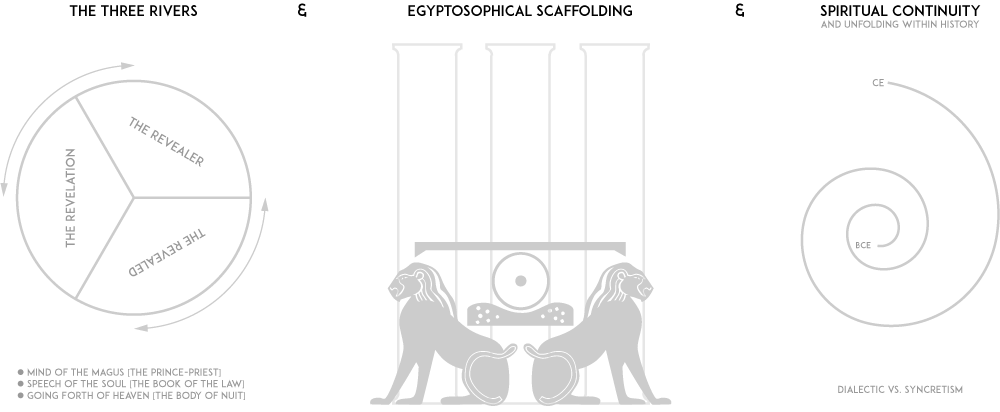
1. The Three Rivers (& To Take Refuge Therein)
The Three Rivers are: (a) The Revealer, (b) The Revelation, and (c) The Revealed. These tributaries form the actual body of authority when examining the Law of Thelema through the trifold lens of the Spirit of the Law (The Revealer), the Letter of the Law (The Revelation), and the Tradition of the Law (The Revealed). Any one of these without the others is unbalanced authority and becomes pathological.
The Three Rivers also forms the basis of "Refuge" for an adherents much like the Buddhist refuge of Buddha, Dharma, and Sangha, respectively.
2. Egyptosophical Scaffolding
I believe we have to be careful with asserting an egyptological centrality within the Book of the Law rather than an egyptosophical influence[1] adjacent to the Book of the Law.
Ultimately, Egyptosophy is about fantasy. It is the assertion that a romanticized and imaginary Egypt is the wellspring of all esotericism. Fantasy, however that is defined, shouldn’t be an elimination factor when exploring any kind of religious strain or technology. The much derided Scientology and its space opera, the Urantia Book and its space/ascended masters mythology, even Theosophy and its fantastical Tibetan assertions, Christianity with its borrowed creation stories (among others), or Mormonism and its occult connections with angelology—all these and so many others are grounded in a sense of fantasy that makes up a good portion of their doctrinal mythos.
With the Book of the Law, we find these egyptoid concepts (ex. Nuit, Hadit, Ra-Hoor, Khabs, Khu, etc) all loosely connected to the flavor of a mythical Egypt. Yet we are reminded regularly by the Prophet himself that Thelema transcends the past, that it revolutionizes all aspects of humanity. The masturbation-by-numbers continued by OTO insiders and Crowleyan Fundamentalists ignores this revolutionary aspect of Thelema and continues to pigeonhole the past into the present and wipe away any progress into the future. Thelema uses symbols, like these egyptosophical vapors, to provide parameters for reality through the perspective of a new consciousness. One might say that in order to assert the truth, Thelema uses falsehoods to reach around the objections of the conscious mind and offers a symbolic representation of life, the universe, and everything. (Nietzsche comes to mind here.)
3. Spiritual Continuity and the Dialectic Unfolding Within History
Thelema proposes an inherently Dialectic view of history (aeons) rather than a syncretic accumulation of religious form and function. While it is correct that assimilation (and to a lesser extent, syncretism) is somewhat unavoidable in any religious culture due to the influence of ideas in motion through temporal history, there is a huge difference between a syncretic fusion of ideas and a Dialectic movement within the frame of history. All major spiritual (aeonic) movement is Dialectic, not syncretic.
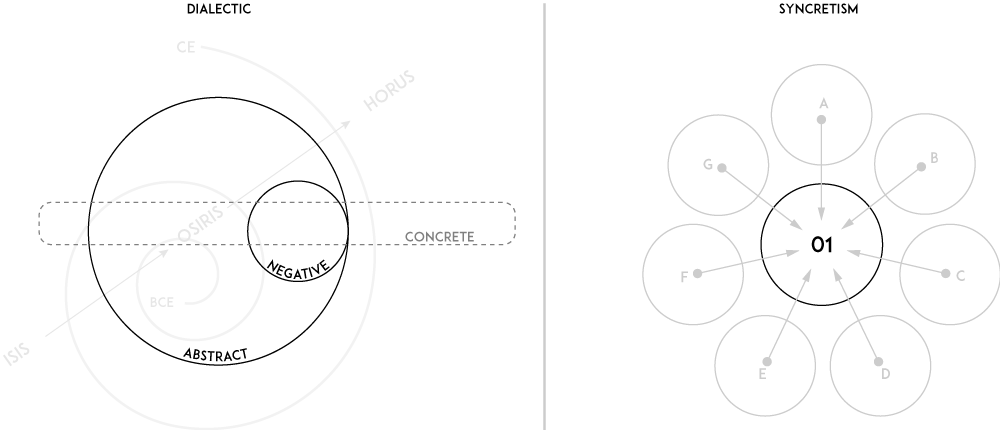
It should be noted that, unlike most occult and New Thought influenced history, the Dialectic approach within Thelema (and reality, for that matter) does not propose that progress through time inherently offers a "better than" present or future in relation to the past. While some things do get better, from one perspective, not everything could be seen as such. For example, capitalism brought about an increase in the living conditions for the majority of the planet but it also accelerated the destruction of the ecosphere in which we live.
Developing a Systematic Thelema
Systematic Thelema is not
- focused on a single doctrinal theme or pericope study,
- a historical review,
- comprehensive commentary to the Book of the Law, or
- body of infallible truths.
Systematic Thelema is
- comprehensive: covers all aspects of a doctrine or set of doctrines as fully as possible,
- coherent: shows a clear, consistent message of the Book of the Law,
- contextual: engages historical and contemporary points of view,
- conversational: interprets the fullness of doctrine in terms of contemporary questions, existential anxiety, and the human situation,
- a process not a directive, and
- inherently incomplete
What is Thelema?
Natural vs Special Revelation
Thelema is found within two aspects of revelation: that is, in both a natural (general) revelation and a special (specific) revelation. This isn’t some new idea. All revelation through history has been upheld in pretty much the same manner. The only difference we have with Thelema is that it is the first truly universal revelation to humanity. As Crowley says, it “is the first Law ever given to man which is a true Law for all men in every place and time."[2]
Natural (General) Revelation
A natural (general) revelation is that which is all around us. It is not specific to any individual, group, society, or culture. It is a natural phenomena that exists in the same manner and to the same end that “bid Stars to shine, Vines to bear grapes, Water to seek its level.”[3] The natural (general) revelation itself is not bound to any particular form only that any form it takes will radiate from the Law itself in the four rays of Light, Life, Love, and Liberty. You will find these concepts are directly related to any kind of mythic descriptor that is valid in reference to Thelema. Those who claim Thelema is a “force of nature” are referring specifically to this quality as general revelation. When you see Thelema referenced as "like The Tao" or "The Western Tao," it is as an analogy to this natural revelation.
Special (Specific) Revelation
A special (specific) revelation means pretty much just that: a specific revelation to a specific person or persons in a specific time and location within history. While there may be other debatable texts that are found within the doctrinal reaches of the new aeon, the only source and simple surety we have that defines the special revelation of the Law of Thelema is Liber AL vel Legis, the Book of the Law. Quite frankly, everything else is an add-on. Even the additional so-called "Class A" texts inspired by Crowley himself as additional texts, despite their incredibly inspirational nature, are specific to Crowley and his old aeon perceptions of the Law and its adjacent practices and beliefs.
Defining Thelema
Thelema is variously called a philosophy, a religion, a worldview, a paradigm, and a culture. It falls under many different terms to explain what it is in some nebulous manner. No matter how it is viewed, it is a robust approach to the human condition, to the ultimate concern of the individual, of the community, and of the planet.
Many have attempted to define Thelema through a single verse—“Do what thou wilt shall be the whole of the Law.” Then they say something, like, it means that you are supposed to be “finding out precisely who you are and what you want to do with your life—and then doing it."[4] Or “doing the True Will means doing what you truly want to do."[5] Or nebulously defining Thelema so that it looks royally academic as "a philosophical, mystical, and cultural system that is based upon a seemingly simple premise: DO WHAT THOU WILT."[6] All of these are incorrect in varying degrees.
So there is no misunderstanding with what I’m saying: without a doubt I would argue along with many others that “Do what thou wilt shall be the whole of the Law” is a central tenet of the Law of Thelema. I am not convinced that it is a foundational premise or basic Axiom of Thelema.[7] I believe it to be a corollary (or, more properly, a summary) of the principles concisely laid out in the Book of the Law. It would be like saying, “Whatever you want men to do to you, do also to them is the whole of the Jewish Law."[8] It is certainly truthful; but it is an oversimplification while remaining an excellent mnemonic device for those that don’t want or need to spend a great deal of time wading through the rest of the muck of theory and philosophy.
Defining Thelema must be in a manner that is obvious and accessible to all. We must start with the recognition that the Law is for all (AL 1.34) and that none are left out. I believe any legitimate examination of Thelema must take into account a direct and well-rounded approach. It must be able to satisfactorily answer four questions: that of origin, meaning of life, morality, and destiny. The first three of these questions requires an approach that encompasses Metaphysics (ontology), epistemology, Ethics, and, as an extension of ethics, politics. (Destiny via eschatology will be covered elsewhere.)
In 1936, Crowley wrote to C.S. Jones:[9]
Our sole business should be to use the Law to reconstruct the world from the chaos into which it is already half tumbled. That formula is a simple one, and requires no specialised training. The work requires the cooperation of tens of thousands of people who have never heard of the Qabalah, and they have to be addressed in language which they can understand (emphasis mine).
This holds true even more so in our contemporary society. Therefore, any definition of Thelema must be able to express these previously mentioned four aspects of the human condition in as distinct a manner as possible and as understandable to a broader swath of population than merely "occulture."
To that end, I believe the following definition offers that perspective and accomplishes the task set out for it while continuing to open doors for further questions and discussions.
Foundation of Thelemic Philosophy
The foundation of Thelemic philosophy encompasses Metaphysics (ontology), epistemology, Ethics, and politics. A further theory of aesthetics could be made, but is avoided here for the moment.[10]
1. Metaphysics: individual authenticity
2. Epistemology:* self-discovery
3. Ethics: personal accountability
4. Thelemic Politics (Notes): social responsibility
If I were to express these concepts further in plain English, I would do so like this:
- You are the center of your own universe,
- You are more than the sum of your parts,
- There is no such thing as a free lunch, and
- Our universe includes other Stars. Act accordingly.
Within this particular approach, each category of philosophy builds on the previous aspect as such:
Metaphysics leads to epistemology, Epistemology leads to Ethics, Ethics leads to politics (and aesthetics).
You will find that each of the particular frameworks associated with these philosophical categories builds on the previous in a logical manner:
individual authenticity leads to self-discovery; self-discovery leads to personal accountability; Personal accountability leads to social responsibility.[11]
With these categories and frameworks of philosophy in mind, the same definition of Thelema can be expanded with annotations for further clarity and discussion:
Definition: Thelema is the philosophy [intellectual approach] and religion [emotional approach] of individual authenticity [Metaphysics], self-discovery [epistemology], personal accountability [Ethics], and social responsibility [politics] based on the path of enlightenment [condition of being informed spiritually] found within the Thelemic canon, specifically Liber AL vel Legis.
The Three Pillars of Thelemic Philosophy (or Street Theology)
I have to give Joshua Gadbois (Rufus Opus) credit for this.[12] He explained to me the outline for one of his hermetic courses in which the student is asked three questions: Who are you? Why are you here? What are you going to do about it? It was brilliant.
He and I discussed extensively how the way this breaks down from the categories above as Who are you? (Metaphysics) Why are you here? (epistemology) What are you going to do about it? (Ethics and politics). It's really quite a beautiful arrangement that allows for even more depth in our approach to personal philosophy and yet grounds it in useful language that is available to everyone. I call it Street Theology.
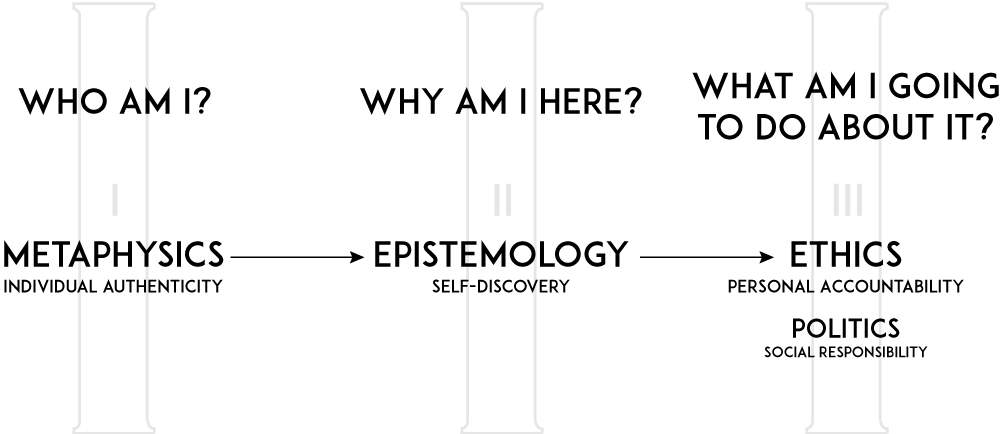
Hierological Foundation of the Three Pillars
It is not enough to merely pick words out of the air and suggest they are hierologically sound. Given the Book of the Law as the foundation of all-things-Thelema, it is wise to ensure that these pillars are secure also from a scriptural position.
To that end, I submit these same areas of focus can be expressed as follows:
Who are you?
Metaphysics: Every man and every woman is a star. (AL 1.3)Why are you here?
Epistemology: Do what thou wilt shall be the whole of the Law. (AL 1.40)What are you going to do about it?
Ethics: So with thy all; thou hast no right but to do thy will. (AL 1.42)
Thelemic Politics (Notes): Love all, lest perchance is a King concealed! (AL 2.59)
Four Validity Domains
While Metaphysics will tell us about the nature of the universe in which we live and the experience we accumulate as a matter of our existence, a detour must be taken in order to understand the validity domains of how we process experience. To do this, we must examine epistemology as informed by the Law of Thelema.
epistemology is, simply put, the study of knowledge. I have avoided the distinction between epistemology and gnoseology due to the over-reliance and abuse of the word 'gnosis' in modern occult circles. While there is a difference, it's not enough at this stage of examination to split hairs over the distinction.
In Thelema, epistemology could be approached as self-discovery. While there is some throwback to Metaphysics here—every man and every woman is a star; each individual is the center of their own universe; &c—it is important to understand how it is that we gather knowledge of ourselves, of each other, and of our environment. This is the purview of epistemology.
Any theory of Thelemic epistemology must take into account multiple dimensions that include both Objective reality as much as we can interact with it and subjective reality that shapes the manner in which we perceive our inner states as well as the world-at-large. We also have to take into account both systemic structures in which we function and the cultural environment that shapes our underlying assumptions. This offers up four validity domains.
Borrowing a breakdown from Wilber's AQAL modal,[13] we find these four domains to be Objective [Axis I], subjective [Axis II], interobjective [Axis III], and intersubjective [Axis IV]. All entities [Stars] and experiences [point-events] inherently have these four validity domains from which we can explore our assumptions about individual and collective perceptions of reality.
We will continue to come back to this approach multiple times as it is far more elegant a solution than many others.
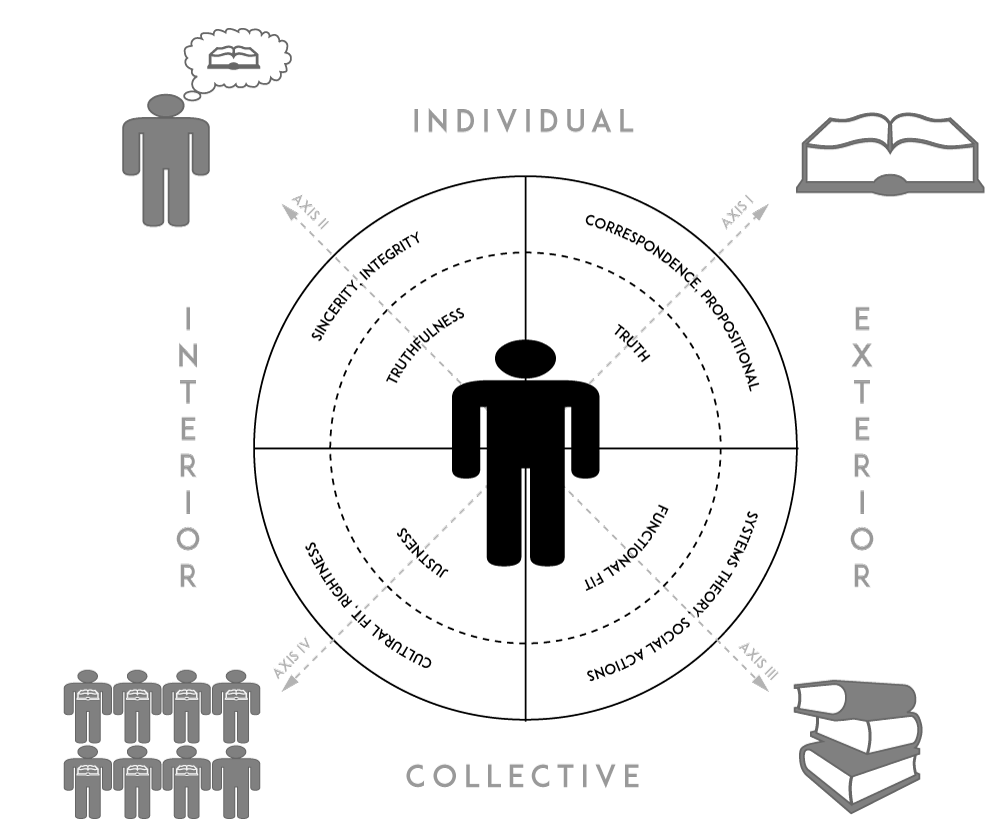
A Note About Left-Hand and Right-Hand Paths
Something that comes up a lot in occult spaces is this idea of the "Right-Hand Path" and the "Left-Hand Path." For most of occulture's modern history, these have been fixated on moral justifications for diametrically opposed ideologies and praxes. The Left-Hand Path is little more than Twinkies for angsty teenagers. The Right-Hand Path is just another name for those who prefer rules and regulations over experience and can't seem to keep their noses to themselves.
Wilber[14] offers a different view of these "paths" in light of the AQAL model I've just referenced. It is a far more balanced look that escapes the moral view and squarely places these "paths" into a more useful understanding. We can see this in the diagram above that the "right-hand" side is all exteriors. These are surface elements that we see in a broad view (span). We measure these things—even when they are just ideas or theoretical. The "left-hand" side is all interiors. This is the material we have to interpret (depth).
Granted, there is some crossover between them—as any model is just that, a model, not a perfect representation of reality. But the point stands here that Right-Hand and Left-Hand are both necessary for a balanced approach. We cannot have one without the other.
Thelema is neither a "Left-Hand Path" nor "Right-Hand Path" philosophy or religion. It is an integral philosophy and religion. It is both individual and collective. It is an individual belief and a cultural worldview, and it exists within various systemic and structural elements.
Thelemic Cosmology & Ontological Taxonomy
Crowley was quite clear that a new aeon demanded new models (or "systems of classification"[15]). While the Tree of Life is the predominate form of structure for most Thelemites, even Crowley knew that it was inadequate for the task of representing the perspective of the new aeon. However, he left nothing behind except a slavish adherence to a bastardized Kabbalah/Qabala and its iconography. We can do better.
To this end, a new model is offered here that presents, not a fall from grace or from the face of God or the need to crawl back up "the Tree," but as a whole, integral, perfect Star on a journey, with a destiny, and an updated expansion of the Khu and workable explanation for pursuit of the Great Work ["solution of complexes"]. What this model also accomplishes is moving materialism away from a sense of "lower than higher" spiritual perspectives.
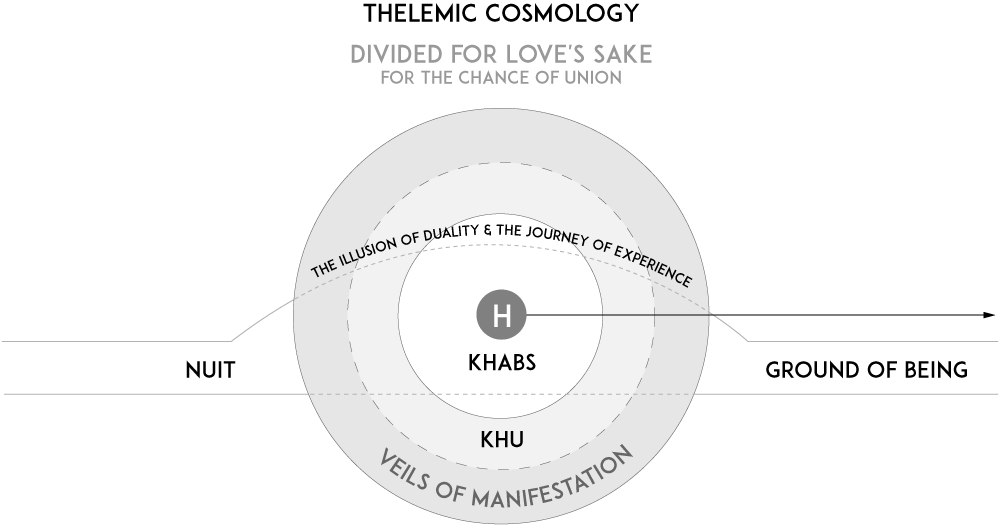
Further Explanation of the Thelemic Cosmology Model (TCM)
Aside from the aesthetic aspect of the model itself, being circular or round in the doctrinal nature of a Star, there are some distinct taxonomic features (and axioms) that should be pointed out.
Nuit as Ground of Being
First, Nuit is indicated as a selection that runs throughout and around the entire circular model itself. This is to show that Nuit is the representation of the ground of being, being-itself or that which holds all being and non-being. It cannot be a "thing" or else it would have a causation that comes before it. Nuit is all of existence in posse (potentially) and in esse (actually) but is neither essence or existence yet that which undergirds them both (being-itself).
Basic axioms:
Existence: "existence asserts the right to exist" (Liber ABA, p. 579); "Nuit is All that which exists, and the condition of that existence." (NC to AL 1.22, emphasis mine)[16]
Consciousness: "the continuity of existence" (AL 1.26e)
Identity: A is A. (Liber ABA, p. 143fn); "There is none that shall be cast down or lifted up: all is ever as it was." (AL 2.58d)
Ontological taxonomy:
Ground of Being: Nu! the hiding of Hadit. (AL 2.1) "Being itself, as present in the ontological awareness, is power of Being but not the most powerful being: it is neither ens realissimum (the most real being) nor ens singularissimum (the most single being). It is the power in everything that has power, be it a universal or an individual, a thing or an experience."[17]
Hadit as Ground of Becoming
Second, Hadit (indicated by the 'H') is the core of the Star. Hadit is the motion-itself of the Star, differentiating itself from any other, the ground of becoming. This essential yet impersonal aspect of the Star is Hadit. It is that motion which causes change by gathering experience through the interaction of the Khu with all actual and possible experiences. The arrow from the center is this symbol of motion. It is this motion which creates the illusion of duality which is the journey of experience for each Star.
Ontological taxonomy:
Ground of Becoming: "Had! The manifestation of Nuit." (AL 1.1) Therefore, by the lapse of time, and by virtue of memory, a thing could become something more than itself; thus a real development is possible.” (NC on AL 1.3)
Core of Every Star: "Every man and every woman is a star." (AL 1.3) "I am the flame that burns in every heart of man, and in the core of every star. I am Life, and the giver of Life, yet therefore is the knowledge of me the knowledge of death." (AL 2.6)
Ra-Hoor-Khuit as Destiny-in-Motion
Third, the Khabs is the direction of the Star, the expression of the True Will, and rightfully considered the Holy Guardian Angel, the Authentic Self of the individual.[18]
Basic axioms:
Interior Construction: "The Khabs is in the Khu, not the Khu in the Khabs." (AL 1.8) "We have seen that Ra-Hoor-Khuit is in one sense the Silent Self in a man, a Name of his Khabs, not so impersonal as Hadit, but the first and least untrue formulation of the Ego. We are to reverse this self in us, then, not to suppress it and subordinate it. Nor are we to evade it, but to come to it." (NC to AL 3.62)
Ontological taxonomy:
Manifestation of Destiny: "The circumference of Nuit touches Ra-Hoor-Khuit, Kether; but her centre Hadit is forever concealed above Kether." (OC to AL 2.4) "Ra-Hoor-Khuit is the Crowned and Conquering Child. This is also a reference to the 'Crowned' and Conquering 'Child' in ourselves, our own personal God." (NC to AL 3.22)
Khu as the Veils of Manifestation
Fourth, the Khu is the (a) personality, (b) profile, and (c) presentation of the individual, the veils of manifestation or experience. The Khu is the aspect we explore through the Great Work. It is that through which we dig in our personal archeology of authenticity.
Basic axioms:
Exterior Construction: "The Khabs is in the Khu, not the Khu in the Khabs." (AL 1.8)
Thelemic Ontological Conjunctions (or Structures)
- Individual & Universal — resistance & participation / agency & communion / division & union (AL 1.29)
- Becoming & Being — dynamics & form / potentiality & manifestation (as will or movement)
- Liberty & Destiny — free will & determinism / change & maintenance
See Ontology
The New Logos
There is a misunderstanding of the nature of the logos as meaning “The Word.” It comes down to us as a common interpretation from the Book of St. John and repeated often enough as merely the manifested or divine logos walking among mankind. This is absurd. When we use the term “word” in some grammatical sense, we mean lexis [λέξις]. But logos is something different, deeper, with a sense of meaning that exists beyond a mere “word.”
As a concept, logos [λόγος] exists alongside its fellow concepts of ethos [ἦθος], pathos [πάθος], and mythos [μῦθος]. It does not exist in a vacuum. Logos can be defined as “the premise or the 'argument' itself, the explicit reasons [the logic] the arguer provides to support a position."[19] It is the underlying logic, reason, mystery. This is why, in the construction of the four spirto-historical threads in the Canons, logos is further described as “the premise of life.”
The representative logos of each aeon offers as its primary function the exemplar of purpose for the aeon itself. But it is also the physical anchor of the aeon to that purpose. The role of the logos is to provide the explicit reasons, the logic, of the aeon for the whole of humanity and functions as a conduit for the revelation of the message of the aeon as seen through the lens of action.
The Great Work
Crowley insists, in multiple different ways in various places throughout his corpus, that the Great Work is the manner by which we come into the Knowledge and Conversation of our True Will, of that distillation of our Will into a single Word, a personal logos, or self-referential meaning-itself. (It is this aspect of the Great Work that asks Who am I? and Why am I here?) How? Crowley again states “The Great Work therefore consists principally in the solution of complexes” (NC to AL 1.8). This is quite specific. It doesn’t happen with a single ritual attempt or over a weekend or two but demystifying this whole concept is important.
The Great Work could be presented as one approach toward our own soteriological alignment. What I mean is the solution of complexes has to be the archeology of authenticity, it has to be about smoothing out the veils of the Khu (personality, complexes, experiences, &c) in the direction of grasping the nature of our own Khabs (soul, Holy Guardian Angel, direction of motion, True Will, &c). It is not our salvation from Sin or damnation, but the alignment (or right relationship) of our Khabs inward toward Hadit and ultimately toward Nuit herself.
Within this inward journey, this first crisis of the individual, it is about the interior influencing the exterior; that is, once we come to understand our True Will, this authentic self, then we begin to ensure that everything exterior about ourselves is overshadowed by our understanding of that True Will. One might use the metaphor of "the Angel whispering" to us in directing our path through life. This is different from the outward journey, the second crisis—not shown here—in which the exterior conforms to the interior and produces "a permanent and fundamental revolution in the whole of one's being."[2:1] This latter could be alluded to as "the Angel taking over" the whole being of the individual.
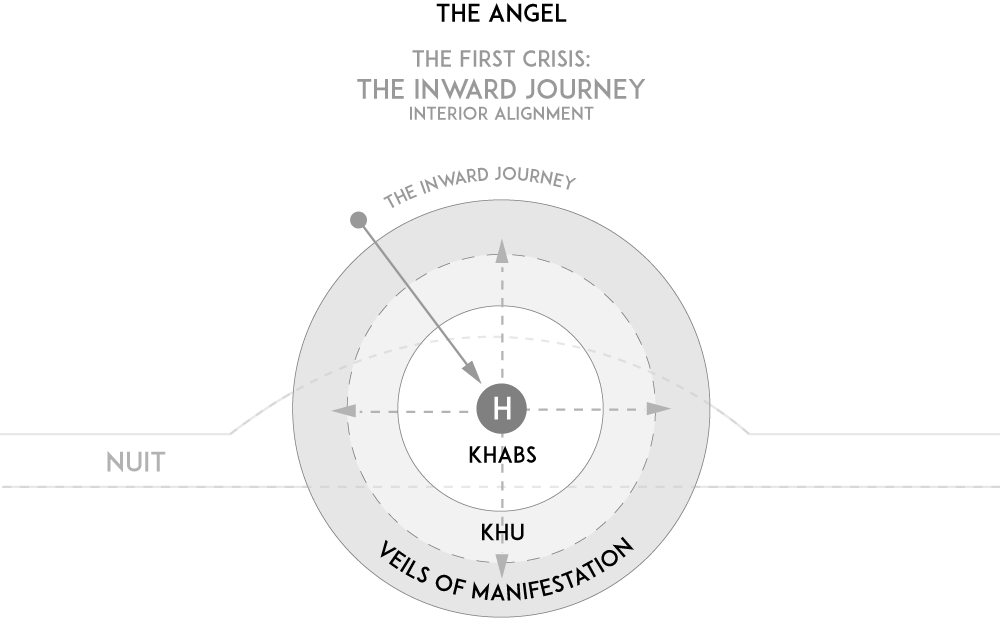
Our first journey—that which is typically exemplified by the poetic language of both the Great Work and Knowledge and Conversation of the Holy Guardian Angel—is an inward journey through the solution of complexes, beyond the illusion of duality, to align with that True or Authentic Self (with the direction of motion) that constitutes our True Will which then shapes outwardly our movement in alignment with destiny-itself. Crowley felt this was the "next step of humanity" and that it is as simple for the individual as to “assimilate the Law of Thelema, and make it the norm of his conscious being; this by itself will suffice to initiate him, to dissolve his complexes, to unveil himself to himself; and so shall he attain the Knowledge and Conversation of his Holy Guardian Angel" (NC to AL 3.60).
There is a distinct difference between this model and that of the Tree of Life. While it can be stressed that the "climb up the Tree" is really a path inward, there is still the visual and experiential aspect of "moving upward" or "ascending to God" (or self or divinity or whatever). The utilization of the alethiological (cartography) model allows for the visual and experiential expression of the Great Work to be seen definitively as an inward journey that is not fraught with "spheres" of attainment, but of a journey of self-discovery, an epistemological distinction of note that relies on a different metaphysical assumption than that of the Tree of Life. We are not reaching back or up toward a Godhead of which we are a mere spark. That heresy is one Crowley has already put aside for us as "a senseless and inexcusable folly" (NC to AL 1.8). However, the alethiological (cartography) model [vida infra] provides a look at how we are already Very God of Very God, Nuit-in-motion. The journey of discovery is not about finding that which is missing but exposing that which is already existent.
Cartography of a Star (Alethiological Model)
The alethiological (cartography) model is predicated on the assumption of a necessary foundation for personal initiation (and as a jump point for a theoretical orientation for psychology as informed by the Law of Thelema) and for the Great Work as illuminated by Crowley when he wrote, "Let him, before beginning his Work, endeavour to map out his own being …".[3:1] This may be one of the most important—and overlooked—dictates for starting any spiritual endeavor. How can we know we are even capable of the journey if we are unsure of what capabilities we possess in the first place?
The alethiological (cartography) model takes the four validity domains, builds on the model of Thelemic Cosmology (TCM), and expands them further into our personal and collective space while delineating the features of an ontological taxonomy that satisfies the doctrinal constitution of a Star.
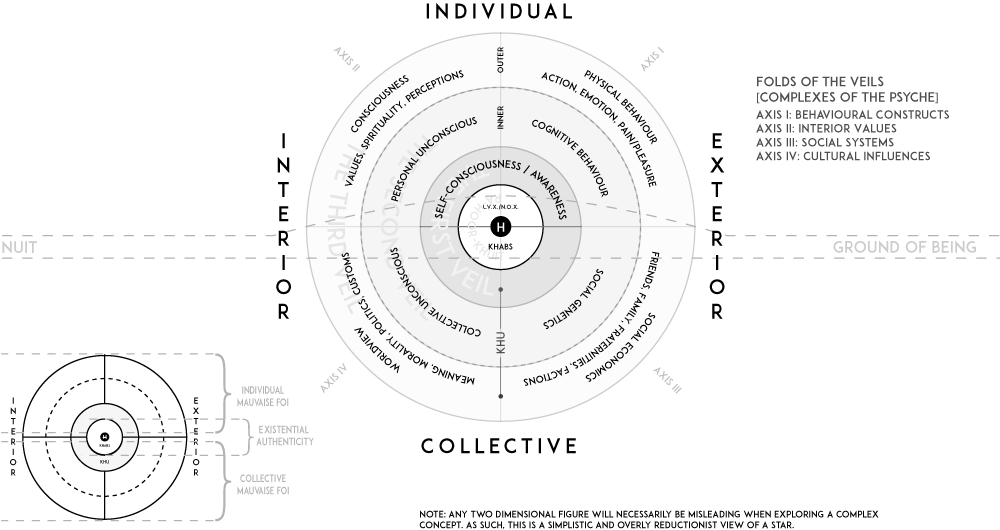
Folds of the Veils of Manifestation / Complexes of the Psyche
What the Book of the Law calls the Khu, we can understand readily as the veils of manifestation or, in more psychological terms, the complexes of the psyche. However, rather than settling with Freud's ideas of complexes being mere subconscious hangups, the alethiological (cartography) model expands on similar concepts throughout all four validity domains in relation to the Star itself via a modified use of Wilber's AQAL modal.[13:1] Each of these axes has an outside and inside element.
Each of these could take up a whole essay or chapter of a book to delve into the intricacies of each quadrant, but only a brief review is offered here. Future presentations would provide further explanation into each of these from both the standpoint of the Great Work and an approach to a theoretical orientation for Thelemic Psychology (Notes).
Behavioral Constructs Objective—Individual Exterior
This is that Upper Right quadrant on the Cartography diagram. In this case, the outside is all about physical behavior, actions, emotions, pain and pleasure, &c. These are physical and biological aspects of the individual that we can experience and measure. On the inside, there is cognitive behavior, but this is the realm of, for instance, what we can see when we take brain scans. We are still looking at what we can measure, what we can quantify in some way.
Interior Values Subjective—Individual Interior
This is the Upper-Left quadrant of consciousness in the sense of outside awareness ("awake-ness"). This is different from that internal mechanism of self-awareness. Here we find our personal values, spirituality, and even our perceptions of the world around us. On the inside, we're looking at our own personal unconsciousness or altered states of consciousness (sleep, dreaming, meditation, hallucinations, &c).
Social Systems Interobjective—Collective Exterior
These are our social connections and frameworks, the social economics of family, friends, fraternities, and factions. This Lower-Right quadrant is the structural makeup of our lives and interactions that shape up whether we understand them or not. The inside aspect of this quadrant is what we might call social genetics, that which generally underlies all instances of a particular structure.
Cultural Influences Intersubjective—Collective Interior
All of our cultural influences are here from our inherited worldview to our search for meaning, our understanding of morality and even our political views (politics, as in parties and structures, fall under those Social Systems of influence). The inside aspect of this Lower-Left quadrant is our collective unconscious.
Further on the Interior Construction of the Star
There are two more aspects of this diagram of importance. The center core [Hadit] and Khabs are identified as existential authenticity and the Khu is labelled with both the individual and collective mauvaise foi. Thelema expresses the ontological tension between resistance [Hadit] and participation [Nuit], the conflict and resolution between existential authenticity and the complexes defined by the multiple veils of existence built up from both individual and collective mauvaise foi (Fr., bad faith).
Existential Authenticity — True Will
This central core, and more specifically the Khabs, is that piece of ourselves that is our Authentic Self, or our Silent/True Self. It is known by several different terms, but authentic is what I think expresses it best. When we talk about True Will in terms offered by Crowley, we find that he's always talking about the purpose or the direction our lives manifest when we have an intimate knowledge and understanding of our deepest nature. We are always pushed by it, but it is not until we fully grasp that authenticity are we able to truly be at peace with that interior drive (Destiny) and wholly enraptured by it to press forward in full knowledge and conversation of the Will.
Mauvaise Foi (Individual and Collective)
Mauvaise foi means "bad faith." It is a borrowed existentialist term that I have taken a bit out of context but I think fits here smoothly. Bad faith [or mauvaise foi] is a philosophical concept utilized by existentialist philosophers Simone de Beauvoir and Jean-Paul Sartre to describe the phenomenon in which human beings, under pressure from social forces, adopt false values and disown their innate freedom, hence acting inauthentically. It is closely related to the concepts of self-deception and resentment.
Each of the aspects of the Khu, the four quadrants, the veils of manifestation both individually and collectively, are that which muddy up our view of the Khabs. Mauvaise foi is defined, generally, as "failure to exercise integrity and autonomy in one's basic life choices." We can see this in each of those quadrants and how such a failure would not only be the addition to those complexes which keep us from that sense of and experience with authenticity. Clearing the Khu, resolving the complexes, the mauvaise foi, is the explicit nature of the Great Work.
Thelemic Psychology / Theoretical Orientation of Four Domains
Spiritual development is a long and arduous journey, an adventure through strange lands full of surprises, difficulties and even dangers. It involves a drastic transmutation of the 'normal' elements of the personality, an awakening of potentialities hitherto dormant, a raising of consciousness to new realms, and a functioning along a new inner dimension. (Roberto Assagioli)[20]
In looking at the form of a Thelemic psychological process or therapeutic journey, what I see as the core foundation of that structure could be phrased as 'the archeology of authenticity'.
The alethiological (cartography) model, when presented for Thelemic Psychology (Notes), is the basis for a new theoretical orientation informed strongly by the psychological models of Ken Wilber,[13:2] the psychological theories and therapeutic processes of Roberto Assagioli,[21] and the work of Robert Schwartz through Internal Family Systems theory. This approach is also specifically grounded in the Law of Thelema for the pursuit of the Great Work; that is, the solution of complexes in a manner that extends psychotherapy and other techniques through the four validity domains of the individual.
Thelemic Psychology: A Theoretical Orientation
- The human experience can be explicated simply as Perfection-experiencing-Imperfection for the purpose of accumulating change.
- There is only a single essential [authentic] self with a multiplicity of existential masks/garments or subpersonalities. There is no "higher" or "lower" Self/self dichotomy.
- Each individual and each experience of the individual is an existential composite of the four validity domains—Objective, subjective, interobjective, and intersubjective.
- There are interior and exterior modes of individual and collective expression for the sole purpose of aggregating experience.
- Underlying these four domains is a sense of direction [True Will] that can be discovered and assimilated to best express our purpose in life.
We cannot approach the individual in any therapeutic manner through a single lens. We must explore all aspects of the individual and the situation in which the individual finds themselves. All encounters of the Khu with external or internal stimuli are a matter of relationship.
- More information found here: Thelemic Psychology (Notes)
Thelemic Religion / Spiritual and Cultural Models
The (Hypothetical) Forms of Religion Expression
It is my contention that Thelema holds the keys to multiple religious expressions. That our modern occulture remains locked into a model of Victorian social fraternities is merely unfortunate and betrays a fear of moving out from under the shadow of Crowley's preferences and prejudices.
Extrapolating from the Four Rays of the Law, we might suggest there are four primary paths of religious expression: the cognitive path of philosophy (liberty), the expressive path of gnosis (light), the communitarian path of magick (love), and the contemplative path of mysticism (life). These translate to the path of the teacher, the warrior, the builder, and the adept respectively.
- More information found here: Thelemic Religion (Notes)
Thelemic Politics / The Hornet's Nest
Yeah. Not today Satan. Maybe in some future update.
- A beginning for Thelemic Politics (Notes) is started but nowhere near complete.
Spooky Factor
I'm sorry if this all was too complex and dry and did not contain enough of the "spooky factor." I realize many are still looking for the spooks under the bed, gremlins that sit on their shoulder, and terrifying stories of being thrown around the room by unseen forces. So, okay ...
BOO!
You're welcome.
See Bibliography
Attribution
No part of this publication may be used or redistributed for any purpose without the express prior written consent of the author.
Canons of Thelemic Philosophy & Religion © 1996-2024 by The Society for Thelemic Literature.

Go to: Notes to The Canons | Thelemic Psychology (Notes) | Thelemic Religion (Notes) | Thelemic Politics (Notes)
Comments
If you wish to comment about the materials here, feedback is welcome. Feel free to email questions, comments, and concerns regarding the Canons to admin@thelemicsociety.org.
Hornung, E. (2001). The secret lore of Egypt: Its impact on the west. Cornell University Press. ↩︎
Crowley, A. (1997). The heart of the master & other papers. Tempe, AZ: New Falcon Publications. ↩︎ ↩︎
Crowley, A., Desti, M., & Waddell, L. (1997). Magick: Liber Aba. Weiser Books. ↩︎ ↩︎
Campbell, C. D. (2018). Thelema: An introduction to the life, work & philosophy of Aleister Crowley. Llewellyn Publications. ↩︎
Reichl, D. (2018, November 5). How to do your true will. Mindcoolness. https://www.mindcoolness.com/blog/true-will/ ↩︎
New to Thelema? (2020, August 1). Thelemic Union. https://thelemicunion.com/new/ ↩︎
cf. Balk, A. P. (2018). The law of Thelema: Aleister Crowley's philosophy of true will. Thelema Publications. ↩︎
cf. Matt. 7.12 NKJV ↩︎
Note: For those who believe that later writings of Crowley are to hold more weight than earlier writings, this is a late in life quote and says a lot about his views. ↩︎
Obviously, there are more categories of philosophy than this. However, the four areas of Metaphysics, epistemologypistemology]], Ethics, and politics (plus aesthetics) makes up a complete system of philosophy that covers the majority of the average human sense of lived experience without further complication. Also, this particular breakdown is borrowed from an anecdote by Ayn Rand in "explaining her philosophy while standing on one foot." I find it to be useful when explaining philosophy to non-academics. ↩︎
We could break this all down a different way: Social responsibility is grounded in personal accountability; Personal accountability is grounded in self-discovery; self-discovery is grounded in individual authenticity. ↩︎
I want to give credit where credit is due, but I also want to stress this is not an endorsement of his latest grifting nonsense. If there is one thing I have learned, pop occultism and quickie soundbites packaged with expensive talismans is merely a way to line pockets not actually provide a pathway to understanding. ↩︎
Wilber, K. (2000). Integral psychology. Boston, MA: Shambhala Publications. ↩︎ ↩︎ ↩︎
Wilber, K. (2001). Sex, ecology, spirituality: The spirit of evolution (2nd ed.). Shambhala Publications. ↩︎
Crowley, A., & Harris, F (2017). The book of Thoth: A short essay on the tarot of the Egyptians, being the Equinox, Volume III, No. 5. Newburyport, MA: Weiser Books. ↩︎
OC or NC=Old or New Comment from the Commentaries. ↩︎
Tillich, P. (1946). Two Types of Philosophies of Religion. Union Seminary Quarterly Rev, 1, 3-13. ↩︎
Note: There is still some dispute, for me internally, as to the nature of Ra-Hoor-Khuit. Crowley distinctly felt RHK was representative of the Silent/True Self, which would translate into the Holy Guardian Angel. However, Crowley is also quite explicit that Hadit is the HGA. All in all, the former explanation is more logical when Hadit is viewed as Motion and RHK/Khabs/True Will/HGA viewed as Direction and these being two different but congruent aspects of the same concept which are existentially inseparable. ↩︎
Fahnestock, J. (n.d.). The appeals: Ethos, pathos, and logos. https://members.tripod.com/butler*s/f2002-1002/appeals.html (emphasis in original) ↩︎
Parfitt, W. (1990). The elements of psychosynthesis. Element Books. ↩︎
Assagioli, R. (2000). Psychosynthesis: A collection of basic writings. Synthesis Center. ↩︎